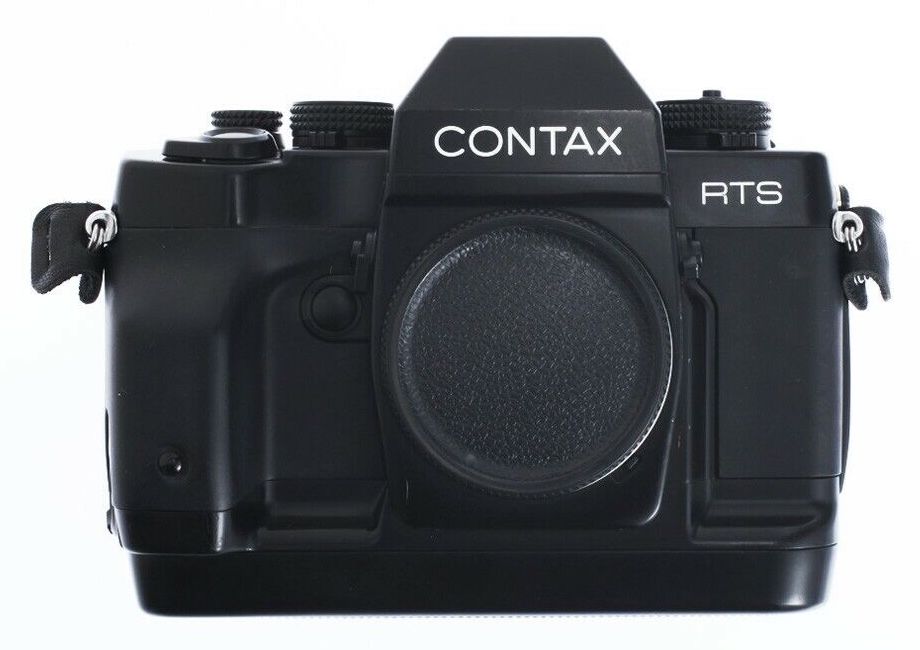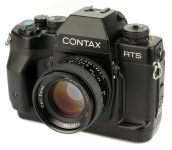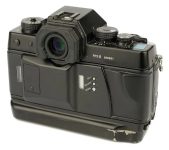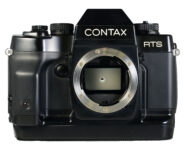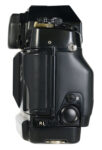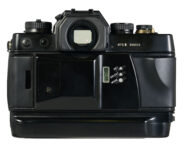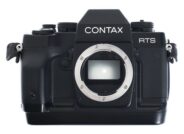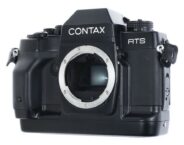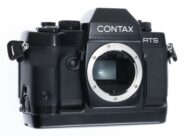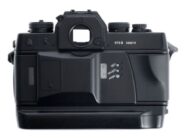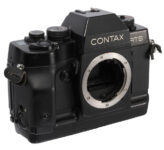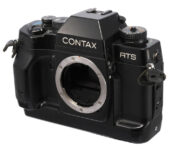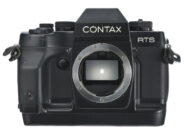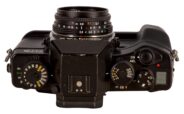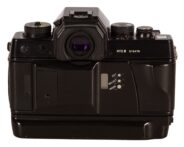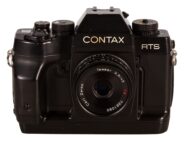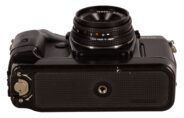Contax RTS III
35mm MF film SLR camera
Specification
| Production details: | |
| Announced: | 1990 |
| System: | ● Contax/Yashica (1975) |
| Format: | |
| Maximum format: | 35mm full frame |
| Film type: | 135 cartridge-loaded film |
| Mount and Flange focal distance: | Contax/Yashica [45.5mm] |
| Shutter: | |
| Type: | Focal-plane |
| Model: | Electronically controlled |
| Speeds: | 32 - 1/8000 + B |
| Exposure: | |
| Exposure metering: | Through-the-lens (TTL), open-aperture |
| Exposure modes: | Aperture-priority Auto |
| Shutter-priority Auto | |
| Manual | |
| Physical characteristics: | |
| Weight: | 1150g |
| Dimensions: | 156x121x66mm |
Manufacturer description #1
The Photographer's Eye
Some people have such a keen sense of hearing that they can discern each instrument in an orchestra playing a Mozart concerto even if the sound reaching them is minuscule.
There are yet others who can listen to but a few bars of an opera or a famous song and have their mind's eye whisk them away to the setting and mood created by the music.
In this same poetic sense, there are truly creative individuals who can find limitless nuances of light and color within a single blossom. These are true artists even if they've never held a paintbrush in their hand or drawn a single line. These are the souls endowed with the innate gift of being able to see with Renoir's eyes.
To those who can sense deep images and great drama hidden behind even the most serene scenes; to those who love to experiment and create images...we dedicate the truest extension of one's eyes that has ever been created, the new photographic standard...the CONTAX RTS III.
A milestone in 35mm SLR history. The birth of the Contax RTS III
Progress in the development of cameras has at times been likened to the way of advancement of musical instruments. The maddening pace at which new electronic technologies have created new directions, multiple functions and an infinity of unprecedented tones and sounds for synthesizers is exponential. Yet there are those people who are not at all at ease with this form of making music. They feel it's change, but not progress. This is one direction.
On the other hand, there are the classical instruments that have a purity of sound, and amongst them a select few that have a purely magical quality in the hands of a master musician. The approach to progress is to seek to perfect the method of creating such a "Stradivarius." This is the true challenge.
So it is today in the world of 35mm SLR's. There are those who are enamored with full camera automation including focus. Then there are the professionals, the following of purists for whom the CONTAX system is designed. They will accept no less than the perfection of the legendary Carl Zeiss T* lenses with the extra edge of creative soft background delivered especially at the fully opened aperture. It was the demands of this dedicated legion that the CONTAX engineers listened to. Give them a more perfect photographic tool closer to the ideal 100% in accuracy, reliability and ruggedness, high versatility, but don't sacrifice creativity through excessive automation. No small order.
The targets were clear. New photographic technologies would need to be developed and completely new approaches made. Autofocus was not a high priority to the CONTAX professionals or engineers. Reaching closer to the 100% performance mark was. With this challenge came the toil that resulted in the CONTAX RTS III. What has been achieved? New standards for professional 35mm SLR cameras. The world's first truly flat film plane even during motor-driven shots, the most rigid body and lens mount yet produced, microcomputerized metering and flash systems that reach a new level of intelligence and accuracy, the extra bright, virtually 100% field viewfinder, to name a few.
The truth is in the results. With the confidence earned through handling the CONTAX RTS III across-the-board accuracy, reliability, durability and operational ease including the extra sharpness of the manual focusing system, professionals will feel it to be the perfect marriage of camera and lens. A "Stradivarius" for photographic professionals who desire their 35mm SLR to be an extension of their personal creativity, not the determiner. The CONTAX RTS III, the paintbrush for the photographer's eye ... a milestone in 35mm SLR standards for a new decade.
In earlier cameras the film plane was not truly flat.
Even before the advent of roll film, camera makers of all formats endeavored to accurately form the sharpest image possible on the film plane. Towards this end, their efforts were devoted to perfecting the design of the lens and its barrel, the mirror box and various other related components. When cassette film came into being, greater attention was paid to the flatness of the film plane itself. First a clamp system was devised, then a spring-loaded film pressure plate attached to the inside back cover was employed, and later, a bottom and top pair of guide rails was added to the latter to form the "tunnel system" currently in vogue. Little modification has followed, although some makers improved on the finishing of the rails or increased the pressure plate size. Not only does the film curl because it lies rolled within the cassette, but also due to temperature and humidity fluctuation affects on the emulsion/film base. Further, distortion can differ according to these factors as well as to the type of film, the number of the frame and whether the film is advanced manually or by motor-drive. In fact, the average film thickness is 0.15mm and tunnel width, 0.2mm; so no matter how good the lens, the film plane could theoretically deviate up to 0.05 mm (50 microns). Tests made by the CONTAX R&D team on currently available top-of-the-line 35mm SLR's, revealed that the film plane flatness error can reach as high as 20~30 microns in extreme cases. Using simple calculations, a lesser, 10-micron, rise of the film would cause rear focus displacement of approx. 1cm when the subject (e.g. a typical portrait picture) is shot at a distance of 3m using a Planar T* 85mm f/1.4 lens. Also, shortly after power winder advancement of the film, it undulates somewhat (albeit on a microscopic level). Such displacement and undulation would certainly result in serious degradation of the final image recorded on the film plane, especially for professional large-scale reproduction use.
How the world's first RTV (Real Time Vacuum) mechanism creates the ultimate in film flatness
Very early in the development of the CONTAX RTS III, the research team came to the realization that the only way to make the film plane really flat was to suck it against the pressure plate. There was already a similar precedent for such an application in rather large, immobile process cameras, but scaling this down and translating it for use in a motor-driven 35mm camera was no easy task. The team soon found that it required an entirely new approach, and at times there were even discussions about abandoning this idea. After repeated experiments utilizing various suction methods, a direct drive, suction rubber configuration akin to a voice coil in an audio speaker was settled on, and it was determined that to enhance suction functioning, the mechanism should be placed just behind the pressure plate. The permanent, highly efficient mini-electromagnet yoke thus drives the moving coil fixed directly to the suction rubber to vacuate the air gap. This mini-mechanism, the RTV (Real Time Vacuum) as such, breaks photographic pioneering ground through its development and use in the CONTAX RTS III for the first time ever in a 35mm SLR. Characteristics of this system are: simple construction, yet high reliability; high-speed motor drive compatibility at up to 5 fps; wide endurability even down to and past -20°C; and vibration-free, film suction even up to 32 seconds (the longest shutter speed in the auto mode). With film stability virtually equivalent to being adhered permanently to the pressure plate, the unique RTV mechanism not only incomparably enhances film frame flatness, but also eliminates even minute frame vibration conventionally found within each shot during high speed consecutive photography. Once you've actually held the CONTAX RTS III in your hands, experienced this highly rational system and seen the impressive results, you'll see why this is the 35mm SLR for a new decade in professional photographic excellence.
Kyocera's unique Fine Ceramic pressure plate
Once it was decided to develop a vacuum mechanism, the flatness of the pressure plate then became of key importance. Conventionally, an aluminum alloy plate has been used, and since the film did not press against this plate, its perfect smoothness and flatness were not of paramount importance. An aluminum alloy plate could only be precision tooled to within a tolerance of a bit more than 10µ, and it would be subject to wear, distortion, aging and environmental conditions. It was decided to develop a ceramic plate as it could be made to a finer tolerance plus have the hardness and rigidity near those of a diamond. The pressure plate would be virtually permanent, not subject to the variables that an aluminum one would. Kyocera, a world leader in fine ceramic know-how, tackled the development of a plate that had to be far closer to a jet black than any other fine ceramic yet produced. For acting like a miniature darkroom, the insides of a camera's mirror box must be free of light and reflective surfaces. Also, an ideal plate surface had to be specially created to interface with the film. Although this pressure plate may look very simple, quite a lot of technological R&D was necessary for its realization. Likewise, was the question of the slits and pinpoint holes for the RTV. How many holes would be best? How should they be made? What shape? Where should they be placed? These were just some of the questions to be tackled. Computer simulation was employed, and the optimal solutions were tested on actual working models. The results - the world's first fine ceramic pressure plate for a 35mm SLR - and the ideal mate for the unique CONTAX RTS III Real Time Vacuum (RTV) mechanism.
Multiple systems with choice and assurance Probably one of the most difficult decisions to make in photography is the exposure, for it expresses the photographer's mood. Light is even more infinitely variable than the subject matter can be. To incorporate a light metering system that can fully cope with these variables, assess the correct exposure with a certainty the photographer can rely on, yet still be versatile enough for creative play ... this is the test of the true professional camera. With the CONTAX RTS III, the challenge has been met by employing four different exposure systems: Center-weighted average or Spot metering with or without A.B.C. (Automatic Bracketing Control), TTL direct flash or Pre-flash TTL spot metering, plus the exposure can be controlled manually, or automatically with shutter speed or aperture priority and even AE Lock. Creativity to choose depends on the photographer.
Center-weighted average metering
For general photography where the main subject is roughly within the approximate center of the picture, this is the well tried and proven exposure system of choice.
Spot metering
When precise, pin-point light metering is necessary for creative decisions, real-time measurement and viewfinder readout of the minimal 3mm center spot (as seen on the focusing screen) can be taken instantaneously. For professionals this is an invaluable tool for checking lighting within components of the frame and making exposure comparisons. For example, a choice can be made to expose for the highlights of a well-lit subject, those of the dimmer background or a median.
A.B.C. (Automatic Bracketing Control)
For pro photographers where tricky lighting conditions necessitate bracketing a one-time opportune shot, the A.B.C system (a world-first CONTAX innovation) is a distinct delight. Three frames can be shot consecutively in the order of normal, over and under (at ±0.5 or ±1EV), automatically, when using shutter speed or aperture priority AE, AE lock and manual exposure even during motor driven operation. This can be especially handy when using slow-speed color reversal films which have a narrow, correct exposure latitude.
Shutter speed or aperture priority AE
AE lock or manual exposure metering is efficiently executed automatically, but exposure control remains with the photographer. There's a choice of shutter speed AE, anywhere from a long 4 seconds to an instantaneous 1/8,000 second ideal for microphotography or capturing motion (blurred or sharp backgrounds); aperture priority AE where the depth-of-field is of paramount importance; AE lock when special lighting or pro creativity warrants it; or manual exposure when the photographer wants complete control.
Super accurate SPD noise-free packages
The SPD (silicon photo diode) cell is the light sensor of choice because of its metering accuracy and reliability. But the light that actually reaches the SPD is quite weak, so the signal must be amplified before the CPU can interpret the data received. Conventionally, this is done near the CPU, after the weak signal has traveled through the circuit. Accordingly, this signal can be adversely influenced by such factors as humidity, circuit noise and external light. In the CONTAX RTS III the aspherical lens, SPD and amplifier IC are all integrated into a single, sealed package. With this new, innovative design, the signal is amplified at the source, thus virtually eliminating such adverse influences. As shown the package behind the viewfinder is for center-weighted, and the double package below the sub-mirror is for spot, pre-flash TTL spot and direct TTL flash, metering.
Direct TTL flash metering
The CONTAX RTS III employs this widely used, highly efficient system because it's especially well-suited for close-ups, diffused and multiple flash lighting. In this metering mode, the actual light reflected from the film plane is accurately measured.
Pre-flash TTL spot metering
Also, the RTS III R&D team felt a more precise flash metering and test combination system was needed. The resultant built-in pre-flash TTL spot metering function when turned ON, automatically stops down the aperture to the preset value, the flash unit emits a burst of light, a 5mm portion in the center of the focusing screen is metered, and the flash duration is stored in the electrically erasable programmable read only memory (E2PROM). With this system, possible error caused by refractive light variation over the frame area or among films is eliminated by taking the light measurement off of a sub-mirror while the main mirror remains down. As long as the lever is ON, the actual flash emitted will be in accordance with this memorized data. Further, if the required illumination exceeds the capability of the flash unit, this difference is displayed in the range of ±2EV within the viewfinder prior to shooting. With manual flash, this is shown as an easy-to-read bar graph. This micro-computer executes measured value memorization/computation/display instantaneously, within even the shortest flash duration of but 1/20,000th of a second. The pre-flash TTL spot metering ... sophisticated operation yet simple handling ... another dimension in creative 35mm SLR photography for a new decade.
Extra bright, long eyepoint viewfinder image
The camera viewfinder can be likened to a painter's studio. If the studio is not bright, flooded with well-balanced light, the artist will not be able to accurately discern the true colors and subtleties of the subject or vividly interpret the image on canvas. So it is with the optical pathway, as it exits the multicoated eyepiece. Ghosting and flare have been reduced to the barest minimum yet. Colors are transmitted faithfully and the long eyepoint design allows the photographer to clearly see and focus through the finder even if held away from the eye. Built into the eyepiece is a shutter and +1D -3D dioptric adjustment.
Extra-large pentaprism, a compromise-free luxury Although the trend in recent years has been to make the camera body more compact, smaller is not always better. Considering the importance of the viewfinder, the R&D team decided to develop a larger, brighter, higher performing optical pentaprism for the CONTAX RTS III. But with increased finder brightness, fine focusing is sometimes a problem when the aperture is stopped down (such as when the preview button is activated) and the image becomes quite dark. With this new prism, even under such conditions the image viewed through the matte screen remains highly visible, and quick, pinpoint focusing is easily achieved. Look through the finder and you'll see why its luxurious image quality has received raves by pros and serious amateurs alike.
Virtually 100% visual field, full-information viewfinder The choice of professionals
With a pro 35mm SLR, only an approx. 100% field of view could be acceptable, and the RTS III's finder screen is distortion-free from corner to corner. There's no guesswork as to what's in the corners of the frame, and because the extremely clear white-on-blue active LCD array provides full compositional information as shown below, the photographer's eye can be kept on the subject at all times.
Newly developed, high performance mirror box
The mirror box and hinge are molded as a single unit so as to be able to withstand even continuous, heavy duty operation. Further, a tough yet lightweight, titanium brace is used to support the specially developed main mirror (coated for enhanced reflection). This mirror box is also newly designed to make it blacker and freer of extraneous light.
The CONTAX approach electronic circuitry for accuracy, minimal controls
The camera is an integral extension of the photographer's creativity, and as such, must be designed for easy use and control to deliver the desired image on film. This point of view cannot be ignored. A full array of "ergonomically designed electronic controls for operational enhancement," a puzzling arrangement of buttons that require complete relearning of how to handle a camera, was exactly what the R&D team felt should be avoided. Handling of the RTS III is essentially the same as that of its predecessors for outwardly, only conservative changes were made. Traditional dials have not been replaced by buttons just for design sake if they function well as is. Rather, the changes were made internally in the sophisticated integrated microcomputer circuitry. Here, the goals were to increase precision, permanent reliability, add new features to improve picture quality, and minimize adverse influences of temperature, high humidity, shake and vibration. Conventional use of variable resistors which are subject to shock, impact and aging was completely eliminated, replaced by digital controls which also have an infinitely faster reaction time.
Conventional controls combined with electronic ones
At the moment the RTS III is taken into hand, there's a conventional feeling of familiarity. It fits snugly into place and the control dials and buttons are where they should be. True, many mechanical buttons have been replaced by electronic switches (like the shutter release and preview buttons), but these are still kept to a minimum while definitely making handling feather-touch smooth and ultra-quick.
Two microcomputers for intelligent, microsecond parallel processing
With the RTS III, two high-performance 8 bit microcomputers are employed in parallel for doing two jobs at the same time; one to give instructions on the basis of data input from the dials/switches, and the other to control the mechanisms receiving these instructions. Such parallel processing is more reliable and with a quicker response time than a single 16 bit one as can be soon felt when handling the CONTAX RTS III. Further, the programs have been written to cancel out errors which could occur from mechanical mechanism chattering (self excited high-pitch oscillation).
Electrical circuit signals isolated from external noise
Even though electronic controls are known to be more reliable than mechanical ones, because the signals traveling the circuit are relatively weak, they are prone to error caused by external electrical noise. The impedance of the entire electronic circuitry within the RTS III was reduced to minimize such unfavorable affects. Further, as explained earlier, noise effects and related fluctuations in metering accuracy have been virtually eliminated by combining the SPD and analog IC into a single package (in house developed and produced).
Digital signal for internal camera communication
In conventional electronic SLR's, the majority of the internal communication is by analog signals which are relatively slow for multi-tasked real-time operations. With the CONTAX RTS III, CAD (Computer Assisted Design) was used in developing the circuitry so that the distance the signals travel could be minimized, digital signals maximized, and analog ones minimized. For example, if the subject is in fluorescent lighting, the anti-flicker counter-measure requires an analog signal to be averaged over approximately ten milli-seconds. A CPU receiving digital signals (like in the RTS III) can execute the same analysis on a real-time basis. Also, with a conventional electronic camera, after it has been completely assembled, circuitry fine tuning at the QC point must be made against a control standard. With the RTS III, these delicate adjustments are made in the CPU on a continuing basis thus also making the camera less subject to the effects of aging.
Newly designed electromagnetic shutter release button
Part of the R&D effort aimed at enhanced reliability centered around in-house production of a highly durable 2-step electromagnetic switch. The one created for the CONTAX RTS III is equal or superior in ruggedness to even the finest class of 1-step mechanical switches, and approx. 5x that of regular 2-step ones.
No compromise-only the top parts and contacts employed throughout Kyocera's uncompromising quality circuit, LSI (Large Scale Integration) and IC know how and products are found throughout the electronic circuitry. To further enhance circuit reliability, the number of contacts were minimized plus key contact points such as on brush portions and at multiple terminals are gold-plated for stronger contact plus high resistance to abrasion and aging. The aperture information brush, for example, doesn't move directly on the resistor, but rather on the printed circuit, thus even after several hundred thousand times the resistance value remains the same.
Top 1/8000 sec. shutter speed and 1/250 sec. flash synch
This newly designed, vertically traveling metal focal plane shutter stops action at up to 1/8000 sec., the fastest shutter speed among top 35mm SLR's today. When this speed is used in conjunction with high speed films, sports photography is a snap. Also, it offers professionals the full opportunity to use Carl Zeiss T*lenses at their creative best ... fully open on a bright day. Operationally superb, the shutter remains highly accurate at an extra long 32 seconds (in auto mode), while the mechanical bulb (B) setting (to prevent excessive power drain) is ideally suited for such applications as astrophotography. Two dedicated flash synchs 1/250 sec. for daylight and 1/125 sec. for general use are available, as well as slower speeds.
Extremely rigid and durable, precision diecast body
Unprecedented body strength and structural rigidity have been achieved through CAD maximization simulation further enhanced by forming the precision diecast body from copper/silumin aluminum and then annealing it with high temperature/pressure steam. Immensely resistant to aging and distortion, this body is also reinforced with a stainless steel lens mount extra sturdily affixed with six screws (vs. usual 4).
Unique top and bottom covers for added strength, yet lightweight, design
To increase the durability of the body without adding significant weight, a new approach was taken for the metals used in the top and bottom covers. Titanium is known for its ability to withstand heavy duty use, but can be stamped only into simple shapes. It was thus used for the bottom which usually takes hard knocks, plus protects the power source. To guard the sensitive flexible circuitry, a very special magnesium/zinc alloy was used for the top as it is extra strong, yet quite lightweight, and can be easily formed into complex shapes. This is the first time this alloy is used in a 35mm SLR. Additional metals were used in the grip and front cover sections. The outer metal parts are specially treated with a smart, highly resilient satin black finish and rubberized sections make for a firm grip.
Three high-powered motors
Driving key operations within the RTS III are three high torque, low noise, top precision coreless motors used within simply configured mechanisms to ensure extremely reliable and durable performance. One raises and lowers the mirror plus charges the shutter, another powers the rewind or stops the aperture down, and the last handles the film winding.
Enhanced film movement with newly advanced mechanism design
R&D advancement has again proven itself in this film-friendly spool drive design. Only full revolution of the spool is needed to advance the film one frame within an unprecedented accuracy of 0.1mm (or less). Completely mechanical and simple (sprocket detection, claw/ratchet system), the usual irregularities due to voltage drops or worn gears are eliminated. An ingenious encoder of the reverse frame counting even ensures that after rewind, a part of the film leader remains out of the cassette.
Beauty in Simplicity
Nomenclature of the parts that make up a uniquely refined whole
Exposure Mode Lever
Simple, single-handed movement of this switch while pushing in on the release button (to prevent erroneous mis-setting) allows for quick selection of aperture (Av) or shutter speed (Tv) priority AE, Manual (M) exposure, or Bulb (B).
Shutter Control Dial
Placed conventionally on the top cover, this dial is speedily rotatable in either direction through click stops for setting shutter speeds from 4 to 1/8000 sec., plus a free X-synch at 1/250sec. and an end locking X-synch at 1/125sec.
Exposure Check Button
Although exposure setting may be checked by halfway depressing the shutter release, it may also sometimes be accidentally tripped. This handy button next to the grip eliminates that possibility. The readout automatically turns off in 16 sees.
Pre-flash Lever
Moving this lever forward when a flash unit is connected to the camera triggers a pre-flash. Light reflected off the sub-mirror is spot metered (a ø5mm area of the focusing screen), the data stored in the E2ROM, and then displayed in the viewfinder even with manual flash units.
Main Switch/AE Lock Lever
When set to the off position, this lever locks the shutter release which it surrounds. Set to AEL, the exposure data in the finder blinks, and consecutive shots at the same exposure value can be taken until the lever is set to ON for routine exposure.
Metering Mode Lever
For available light metering this lever allows for choice of either center-weighted average sensing (up position) or spot (down). While holding the camera, this lever is easily switched with any finger of the left hand, allowing prompt selection of the desired metering mode.
Drive Mode Selector
This lift up-move-stop dial (to prevent mis-operation) allows for single (S), continuous (CL approx. 3fps or CH approx. 5fps) or multiple exposure selection, plus 2 or 10 sec. self-timer delay. When set at multi-exposure, the dial snaps backs to S after each shot.
A.B.C. Lever
When set at '±1' or '0.5' (EV), three consecutive frames are exposed normally, over and under, plus the frame counter at right and in the finder blinks in succession (both, left, right). '0' is off, and the blinking stops.
Exposure Compensation Dial
Using this dial allows for ±2EV compensation in 1/3EV increments while a blinking ' +' or `-' in the viewfinder warns that this dial has been set, thus helping to avoid inadvertently forgetting to reset it to '0.'
Bulb-dedicated Cable Release Socket
In addition to the electromagnetically released bulb setting (with the exposure mode lever), a traditional mechanical hold socket is available on the right side. This allows for conservation of energy when really long exposures are necessary (like in astrophotography)
Mirror-up Lever
For special cases such as in macro and microphotography where it is necessary to supress even minute camera vibration or operating sounds, this lever allows the ultra-lightweight mirror to be locked up, eliminating mirror shock.
Depth-of-Field Preview Button
Pressing this preview button on the left, conveniently confirms the actual in-focus depth before the shot is taken. This confirmation is especially handy when desiring to apply the sophisticated soft focus background appreciated by pros using Carl Zeiss T* lenses.
Data Imprint Between Film Frames
A convenient addition in the RTS III especially for pro photography, data such as year/month/day or day/hour/minute can be imprinted in the vertical margin between frames (made possible by the extra precise film advance), rather than on the valuable photo area.
Vertical Shutter Release
When holding the camera in a vertical position, this additional electromagnetic release allows for very comfortable handling and shutter tripping. Also, when not needed the release can be locked to prevent accidental firing.
Dioptric Adjustment Knob
Simply by pulling this knob up and turning it, the diopter of the eyepiece can be quickly changed from +1D to -3D. This is quite useful to eyeglass wearers who can make the adjustment and then shoot without them. Combined with accessory dioptric compensation lenses, the range can be extended further.
Eyepiece Shutter Lever
For extended exposures such as in AE with the self-timer, a remote control or B (bulb), stray light entering the camera through the eyepiece can adversely affect the photo. By using this lever, the eyepiece shutter is closed so no light enters the eyepiece. This source of error can thus be eliminated.
Manufacturer description #2
Type: 35 mm focal plane shutter, auto exposure single-lens reflex camera.
Picture size: 24 x 36 mm.
Lens mount: Contax/Yashica MM mount.
Shutter: Vertical-travel metal focal-plane shutter.
Shutter Speed: 1/8000 to 32 sec. on auto, 1/8000 to 4 sec., B, and X (1/125 and 1/250 sec.) on manual
Sync Contacts: Direct X contact (synchronizes at 1/250 sec. or slower) and sync terminal.
Self-Timer: Electronic self-timer with a delay of 2 or 10 sec.
Shutter Release: Electromagnetic release, provided with a vertical-position release button, dedicated release socket, and cable release socket for bulb exposure.
Exposure Modes: (1) Aperture priority auto exposure, (2) Shutter-speed-priority auto exposure, (3) Manual exposure, (4) TTL auto-flash, (5) Pre-flash TTL automatic flash, (6) Pre-flash TTL manual flash
Metering System: TTL center-weighted average light metering/TTL spot metering (switchable)
Metering Range: EV 0-21 on center-weighted average light metering and EV 3-21 on spot metering (ISO 100, F1.4)
Film Speed Range: ISO 25-5000 on automatic setting with DX code, ISO 6-6400 on manual setting
AE Lock: The quantity of light on the image surface is stored in memory
Exposure Compensation: +2 EV ~ -2 EV (can be set in 1/3-step increments)
A.B.C. Unit: +/-0.5 EV and +/-1 EV exposure compensating values with A.B.C. lever
Flash Light Control: TTL direct light control
Flash Synchronization Control: Automatic shutter speed setting when flash charging is completed on dedicated flash units.
Viewfinder: Pentaprism eye-level finder (long eye-point type), approx. 100% field of view (no mirror cut-off up to 600mm), 0.74X magnification (with 50 mm lens at infinity)
Diopter Adjustment: Built-in diopter adjuster, +1D ~ -3D correcting range
Focusing Screen: Horizontal split-image/microprism type (standard), interchangeable screens available
Display in Viewfinder: Shutter speed, overexposure/underexposure warning, exposure counter, A.B.C. mode, flashmeter, flash ready indicator, aperture, exposure modes, exposure compensation warning, metering mark.
Display Panel: Exposure counter, film transport mark, battery warning mark.
Film Loading: Auto loading, automatic film positioning to "01" on counter
Film Advance: Auto winding with built-in motor
Film Rewinding: Automatic rewinding with built-in motor, film automatically stops with film tip outside the cassette; can be rewound in mid-roll; about 13 sec. rewinding time (with 36-exposure film)
Exposure Counter: Automatically resetting, additive type; counts down on rewinding; indicates the time that has passed on bulb exposure and self-timer shots as well as the shooting sequence in A.B.C. mode
Accessory Shoe: Direct X-contact hot shoe (provided with TLA flash contact).
Drive Modes: Single-frame, continuous shooting (CL and CH), self-timer (2 sec. and 10 sec.) and multiple exposure modes
Winding Speed: Up to about 3 frames/sec. at CL (with new alkaline batteries), up to about 5 frames/sec. at CH (with new alkaline batteries)
Camera back: Can be opened by camera back release knob; detachable; provided with dating unit and film check window
Pressure Plate: Ceramic pressure plate, RTV attraction system
Aperture Stop-down: With aperture stop-down button (not in "Tv" mode)
Mirror Up: With mirror-up lever
Power Source: Six 1.5 V AA-size alkaline batteries, six 1.2V AA-size Ni-Cd batteries, or one 6V lithium battery (2CR5); built-in lithium data back battery (CR2025) in camera back
Battery Check: Automatic check, battery warning mark in display panel
Battery Capacity: About 120 rolls of 36-exposure film (with AA-size alkaline batteries, at ordinary temperature; as tested according to Contax testing standard)
***
Based on the "Real Time" concept of the Contax RTS series, this Contax camera of the highest class offers, in addition, more sophisticated features such as ultra-fast 1/8000sec. shutter speed, RTV (Real Time Vacuum) system, TTL pre-flash capability, and narrow-area spot metering.
Table of contents
Clickable
Instruction manual
Clickable
Contax/Yashica system cameras
Clickable
- Contax 137 MA Quartz
- Contax 137 MD Quartz
- Contax 139 Quartz
- Contax 159 MM
- Contax 167 MT
- Contax Aria
- Contax AX
- Contax RTS
- Contax RTS II Quartz
- Contax RTS III
- Contax RX
- Contax RX II
- Contax S2
- Contax S2b
- Contax ST
- Yashica 107 Multi Program
- Yashica 108 Multi Program
- Yashica 109 Multi Program
- Yashica FR
- Yashica FR I
- Yashica FR II
- Yashica FX-1
- Yashica FX-103 Program
- Yashica FX-2
- Yashica FX-3
- Yashica FX-3 Super
- Yashica FX-3 Super 2000
- Yashica FX-70 Quartz
- Yashica FX-D Quartz
